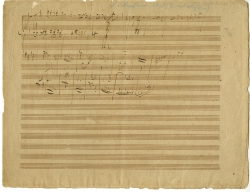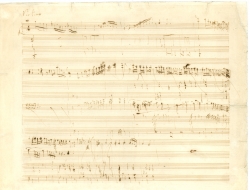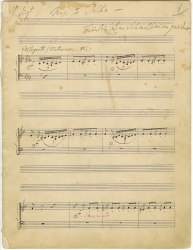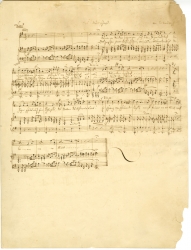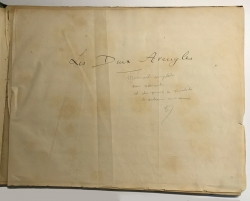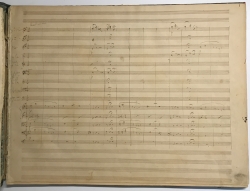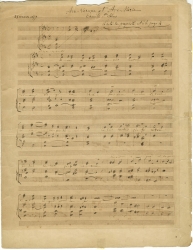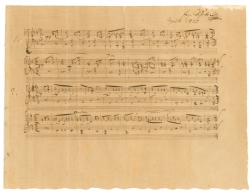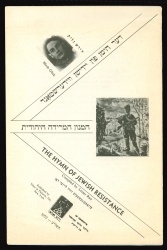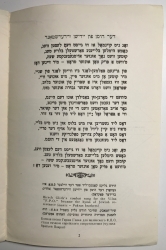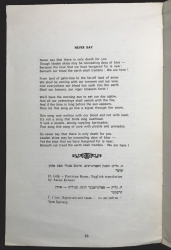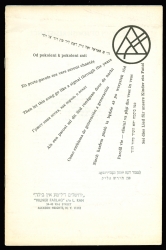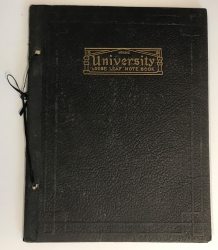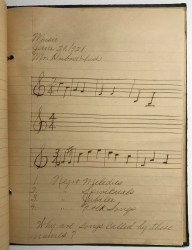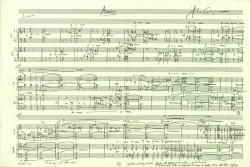The Leon Robbin Gallery is named for Leon Robbin (L’22, Honoris Causa 1997), whose lifelong love of music led him to collect manuscripts, letters and other memorabilia of famous classical composers. He gave many of these to Georgetown, and established the Leon Robbin Library Endowment Fund, allowing the Library to enrich the collection with new materials year on year. This fall we revisit a few treasures exhibited in past years, and, as a coda, include a handful of our most recent musical acquisitions.
Ludwig van Beethoven, 1770-1827
[“Appassionata Sonata”]
Autograph manuscript, not dated but almost certainly 1804, two pages. The more finished page of sketches shows 26 measures intended for the first movement of the sonata, published in 1807 as the composer’s opus 57. Leon Robbin Collection.
Frédéric Chopin, 1810-1849
Autograph manuscript, not dated but probably ca. 1845-1847, one page. Working manuscript, a sketch for a projected work for violin and piano. Formerly in the possession of the composer’s cellist friend, Auguste Franchomme. Purchased on the Leon Robbin Endowment Fund.
Franz Liszt (1811-1886)
“Mephisto Polka”
Copyist’s manuscript, signed, not dated but almost certainly 1883, with Liszt’s inscription “Fräulein Lina Schmalhausen gewidmet,” 18 pages. With numerous revisions in Liszt’s hand and with his autograph addition of optional virtuosic passages as appropriate. The companion piece published together with the third “Mephisto Waltz.” Purchased on the Leon Robbin Endowment Fund.
Felix Mendelssohn, 1809-1847
“Das Waldschloss”
Autograph manuscript, not dated but almost certainly 1835, one page. Setting of a text by Joseph von Eichendorff (1788-1857) for solo voice and piano accompaniment. Leon Robbin Collection.
Jacques Offenbach, 1819-1880
“Les deux aveugles”
Autograph manuscript, not dated but 1855, 34 pages (plus a number of blanks). The working manuscript of Offenbach’s first great success, a bouffonnerie which ran to more than 400 performances following its premiere on July 5, 1855, and which was honored by a command performance before Napoleon III at the Palais des Tuileries. In a binding tantalizingly initialed “J.O.” at the foot of the spine, suggesting the manuscript was bound for the composer himself. Leon Robbin Collection.
Camille Saint-Saëns, 1835-1921
“Ave verum”
Autograph manuscript, March, 1857, five pages. Setting of the familiar liturgical verses for two sopranos, two altos, horn, and organ. Listed without date in The New Grove, but the composer’s note at the end confirms that the work was written while Saint-Saëns still held the organist’s position at the Parisian church of Saint Méry. Purchased on the Leon Robbin Endowment Fund.
Franz Schubert, 1797-1828
Autograph manuscript, signed, April, 1825, one page. Deutsch 841. The two short dances were first published (reproduced from this manuscript) as an illustration to a Stargardt auction catalog in September, 1926; a proper engraved version first appeared in 1930. Leon Robbin Collection.
Coda
Endowment funds continue to allow the Booth Family Center for Special Collections to add to its music-related holdings. These three very different expressions of music, acquired this year, enrich our teaching collections and will provide more avenues for student and faculty research in years to come.
Hirsh Glick (1922-1944)
The Hymn of Jewish Resistance/ Der Himn fun Yidishn Vidershtand/ Himnon ha-Meridah ha-Yehudit [Zog Nit Keynmol]
Introduction by Leizer Ran. New York: Vilno in Pictures, Inc./ lettering on the covers. The publication contains the lyrics of the famous Jewish resistance hymn commonly known as "Zog nit keynmol" (meaning "Never Say"), here translated into English, Hebrew, Russian, French, German, Czech, Romanian, Dutch, Spanish and Polish, in addition to the original Yiddish. Text in English and Yiddish discusses the song and its creation by Hirsch Glick while he was confined in the Vilna Ghetto during the Holocaust. Purchased on the Robert P. Daly Sr. Memorial Endowment Fund.
An African-American Teacher in Alabama Takes Lecture Notes, 1928
Carrie L. Scarborough attended the Birmingham State Normal Branch of Summer Teachers at the Industrial School in the summer of 1928. She took notes on lectures from a variety of important figures, including scientist George Washington Carver, Fannie C. Blevins of Birmingham’s Tuggle Institute, and Rev. Harold Nevers. Much of the notebook records classes in music instruction led by “Mr. Dubose” and “Miss McCarroll.” Open to a June 20 lecture asking, “Why are songs called by these names?” Purchased on the Leon Robbin Endowment Fund.
John B. Corigliano (1938- )
“Amen”
Autograph manuscript, signed. Scored for antiphonal double chorus a cappella. “Amen” was composed in 1994 and first performed in Minneapolis in October 1995. Corigliano’s scores have received the Pulitzer Prize, the Grawemeyer Award, four Grammys and an Oscar. Corigliano serves on the composition faculty at The Juilliard School and is Distinguished Professor of Music at Lehman College, City University of New York. Purchased on the Leon Robbin Endowment Fund.
Exhibition assembled by Stephanie Hughes, Communications and Projects Coordinator, Booth Family Center for Special Collections.
With thanks to former Associate University Librarian for Special Collections George M. Barringer (19xx-2021) for the inclusion here of music manuscript descriptions he wrote for past Robbin Gallery exhibitions.

